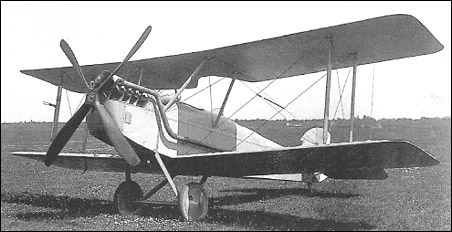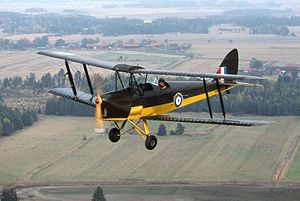Dad (Eric Badcock) was always interested in aircraft and flying and often related stories about them and various happenings over the years. A particular highlight for him was his first flight which occurred at the opening of the Western Junction airport near Launceston, Tasmania on the 28 February, 1931, Dad’s 20th birthday, the plane being a Gypsy Moth.
During the First World War the military soon realised the worth and importance of aircraft for reconnaissance over enemy lines and for the attacking of troops and supplies. Consequently a lot of money and effort was poured into their development and production.
A number of Tasmanians found their way into the Airforce and become pilots and at wars end many returned to Tasmania with several bringing their aircraft with them. One of these was Lieutenant Arthur Long, son of Mr and Mrs T Long of “Torwood”, Tea Tree.
The Examiner newspaper of Wednesday, 17 December, 1919 devoted an article to him and his flying activities and notes that he had made a lot of flights around Launceston. It was almost certainly one of these flights that Dad and his family witnessed while living at Green Rises. His father, Melvyn Badcock, was outside with all the other family members being inside, when they heard him calling out in an excited and urgent tone, “Come out here, come out here”. All rushed outside and Dad and the others there saw an aircraft and in flight for the first time. It was moving through the air seemingly at a slow speed, with the engine sounding something like that of a motorcycle of the time. They watched the plane until it disappeared out of sight.
In later years Dad referred to the pilot as Captain Long but was almost certainly the Lieutenant Arthur Long mentioned above.
The Examiner went onto say that Lieutenant Long was the first person to fly across Bass Strait, this occurring on Tuesday, 16 December, 1919, departing from Stanley at 6.35 a.m. and landing at Fishermen’s Bend, Melbourne at 10.45 a.m.
The paper gave a few details about the plane, it was a Boulton and Paul Biplane and manufactured in England by a company of the same name. The wing span was 28 ft. 6 ins., length 24 ft. 6 ins, and was powered by a V type, eight cylinder air cooled engine, developing 1 800 revolutions per minute and 106 horse power. This engine had been developed by the Royal Aircraft Factory and manufactured by the Lancaster Co Ltd. The machine was a two seater with special and most comfortable seating accommodation.

Several years after the above flight another sensation was caused in the Green Rises district when a plane was forced to make a landing in Harry Greig’s paddock of barley due to a problem with its wings. The plane had been flying near the Great Lake when it made a sharp descent in an air pocket with the wing structure becoming damaged when its downward fall abruptly stopped at the bottom of the pocket. Parts had to be ordered to fix the problem and were several weeks in coming. Pending there arrival the wings were taken off the plane and it was wheeled down the road to Harry Wheeler’s barn and stored there. During its time there, numerous people made their way to the place to inspect the flying machine
Dad and Mum (Elma Badcock nee Page) had their first flight together on Sunday 27 April, 1941, and which was Mum’s first flight, when returning home from their honeymoon, taking the just over thirty minute flight from Hobart to Western Junction. It would be another nine years before their next flight, again late April, 1950, this time to Melbourne and later going onto Sydney, and on this occasion Yvonne and I going with them. Both flights across the Strait was aboard a new and modern aircraft of the time – a four engine DC4 Skymaster and which to us seemed very large in comparison to the DC3s that had mostly been operating previously. A brochure of 1950 described them as “giants of the sky” and from wing tip to wing tip measured 117 ft. 6 ins. and were powered by four 1 450 h.p. propeller-driven engines. They carried a crew of four and up to forty passengers, plus 4 000 lbs of freight.
Over their lifetime Dad and Mum witnessed huge developments in aircraft and flying, the planes gradually getting bigger and faster and much more comfortable to travel in. They saw the introduction of the jet engine and like many other people, marvelled that an aeroplane could travel without a propeller. By the end of their lives, both had travelled a good many times by plane and which to them was always a pleasure.
A number of incidents and events concerning aircraft were sometimes remembered and talked about in the family.
On several occasions in the late ’40s, early ‘50s we went to air pageants held at the Western Junction airport (now the Launceston Airport). Numerous planes, both military and civilian, would be on display, with some being flown to demonstrate their flying abilities. At the pageant held on 3 March, 1947 the pilot of a twin-prop Mosquito aircraft was demonstrating that it was safe to land the plane with one air screw “feathered”. However, the plane overshot the southern boundary, careered through the perimeter fence and hit the railway line embankment with the plane breaking apart. I recall the plane speeding down the runway and a grey flash in the distance as the plane broke apart.

The Launceston newspaper, The Examiner, of 4 March,1947, gives a few details.
"With the air screw still feathered, the plane was coming into land, but did not touch down till over the centre of the landing area. Skid marks on the drome surface indicated that the pilot had endeavoured to break before the Mosquito crashed through the boundary fence. The plane hit the bank of the railway cutting, just outside the fence and skipped across the 25 ft. cutting to the other bank. An aerodrome boundary light was torn up and tangled fencing wire and posts were strewn about both banks. A landing wheel was wrenched from the aircraft and left on the aerodrome side of the cutting, the two airscrews were ripped from the motors which were set back in their mountings, and the fuselage was broken in half behind the main plane. The bottom portion of the aircraft was smashed when it hit the cutting bank. Flt. Lieut. H Moore (the pilot) suffered from multiple lacerations and Flt. Lieut. Mitchell, (the navigator) had a spine injury".
At another air pageant, the weather conditions were poor for flying and the planes were grounded. There was a low cloud base and intermittent showers, with a fairly strong wind blowing. In attendance on the day was one of the local flying instructors, Reg. Munro. He was a well known and well-respected pilot. To entertain the crowd he decided to attempt a vertical lift-off in a Tiger Moth, a fairly light biplane of the time. The plane was wheeled out and placed between two buildings, which created a sought of a wind tunnel. Reg. climbed into the cockpit and started the motor, and while a group of men held the plane steady, he gradually turned up the revs. on the motor and adjusted the wing flaps. Slowly the plane lifted off the ground upwards, with the speed of the motor being adjusted to keep it from going forwards or backwards. He got to a height of about 20 feet before lowering it safely to the ground, to the cheers of the onlookers.
Another air crash sometimes talked about was that which occurred at Cressy in 1942, when two training planes collided. The accident was witnessed by Uncle Viv Richardson and his brother, Eric Richardson. On the same day, Uncle Claude Winwood saw the wreckage as he passed the scene. On the day he had been required to go to Cressy, Tasmania to attend his army call up medical examination, and on hearing of the crash, rode his bike home to Bracknell via the Green Rises road. The wreckage was lying near the power transmission line.
The Examiner newspaper on 5 February, 1942, the day after the accident reported the event under the headline, “Trainer Planes Collide Near Cressy – Three dead include Evandale man”. A few details were given.
"An officer and two airmen were killed yesterday morning when two trainer aircraft from the Elementary Flying Training School at Western Junction collided during a practice flight and crashed about a mile from Cressy.
The victims were -
Flying Officer James Edgar Scascighini, 28, married of Surrey Hills, Victoria.
Sergeant Raymond Harry Dean, 21, single of Evandale, Tas.
Leading Aircraftsman Frank Louis Hurley, 28, single of Armidale, N S W.
Sergeant John Henry, who parachuted to safety was slightly injured.
Both machines were totally destroyed. The cause of the accident is obscure."
On occasions, military aircraft would be seen passing nearby or overhead. One of these was a heavy bomber, either a Lancaster or a Lincoln, flying low and passed directly overhead at “The Grange”. The noise was deafening with the air and ground feeling as though they were shaking.
One Sunday while we were having lunch the whine of approaching aircraft was heard. We all jumped to our feet and hurried outside to investigate There we saw six jets flying together, the RAAFs Roulettes, practising their routines prior to the following days Launceston Regatta where they were due to perform. Besides formation flying they were doing rolls, steep climbs and regrouping exercises, and all the time with engines screaming, and much of it happening above the cows paddock. The cattle took fright and left, probably hoping for a safer paddock, and soon we saw them passing near the house with legs flying and bags swinging. Athol Richardson who was there, was heard to comment, “you could get a milk shake from any one of them”.
The area around Bishopsbourne was designated the No 3 training area for the Western Junction airport. For some years after the war the training of pilots was subsidised and a number of scholarships awarded and this together with returning pilots from the war needing to keep up their flying hours, resulted in much flying in the region. Tiger Moths were frequently flown and hour after hour the planes could be seen flying, and when looping the loop could be seen diving to gather speed and with engine at full throttle would start their climb to loop the loop by which time they had finished their climb, the engine had slowed to almost stalling speed. In fascination we often watched these planes wondering what it would be like to be up there suspended upside down, as they reached the top of the loop.
After the Tiger Moths, the single winged Auster planes became quite common before being replaced by Cessnas and other makes. One of the Austers that continued to fly for many years over The Grange was that owned by Mr. Ernest Mills of “Panshanger” in the Woolmers area of Longford. He owned or leased property in the north west of the State and regularly commuted by plane between the properties. Often in the evening he would pass over our home on his way back to “Panshanger” in his yellow Auster. He would always be flying fairly low and straight and at times, it being almost dark, we often wondered how he could see sufficiently to put the plane down safely.
Since then crop dusters and ultra lights have become common sights and with the occasional helicopter passing by.
Written by Ivan Badcock (Update 21/04/01)

